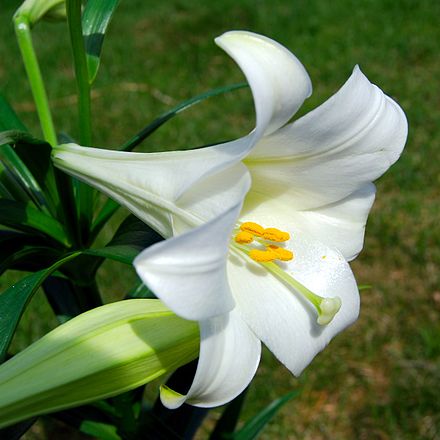Dr. Weeks’ Comments: I have always loved the fragrance of the Easter Lilly and planted the potted plant in the ground after it wilted in order to cultivated them in a garden to enjoy their glory perpetually. Never did I suspect that it is a potent cancer remedy! I want to share with you an assertion which I believe, in time scientists will find to be true: “All plants living today on earth have medicinal properties.” Otherwise stated, a plant can’t survive on earth if it didn’t have medicinal properties.
As for our fellow humans, it is equally true that, when looked at care-full-y enough, all people are beautiful.
J Agric Food Chem. 2011 Jun 8;59(11):5945-54. Epub 2011 May 11.
Antifungal activity and fungal metabolism of steroidal glycosides of Easter lily (Lilium longiflorum Thunb.) by the plant pathogenic fungus, Botrytis cinerea.
Source
Department of Plant Biology and Pathology, Rutgers-The State University of New Jersey, 59 Dudley Road, New Brunswick, New Jersey 08901, USA.
Abstract
Botrytis cinerea Pers. Fr. is a plant pathogenic fungus and the causal organism of blossom blight of Easter lily (Lilium longiflorum Thunb.). Easter lily is a rich source of steroidal glycosides, compounds which may play a role in the plant-pathogen interaction of Easter lily. Five steroidal glycosides, including two steroidal glycoalkaloids and three furostanol saponins, were isolated from L. longiflorum and evaluated for fungal growth inhibition activity against B. cinerea, using an in vitro plate assay. All of the compounds showed fungal growth inhibition activity; however, the natural acetylation of C-6”’ of the terminal glucose in the steroidal glycoalkaloid, (22R,25R)-spirosol-5-en-3β-yl O-α-L-rhamnopyranosyl-(1→2)-[6-O-acetyl-β-D-glucopyranosyl-(1→4)]-β-D-glucopyranoside (2), increased antifungal activity by inhibiting the rate of metabolism of the compound by B. cinerea. Acetylation of the glycoalkaloid may be a plant defense response to the evolution of detoxifying mechanisms by the pathogen. The biotransformation of the steroidal glycoalkaloids by B. cinerea led to the isolation and characterization of several fungal metabolites. The fungal metabolites that were generated in the model system were also identified in Easter lily tissues infected with the fungus by LC-MS. In addition, a steroidal glycoalkaloid, (22R,25R)-spirosol-5-en-3β-yl O-α-L-rhamnopyranosyl-(1→2)-β-D-glucopyranoside (6), was identified as both a fungal metabolite of the steroidal glycoalkaloids and as a natural product in L. longiflorum for the first time.
Volume 76, Issue 6, 24 December 2004, Pages 671-683
Constituents in Easter lily flowers with medicinal activity
- Jayaraj A. Francisa,
- a Bioactive Natural Products and Phytoceuticals, Department of Horticulture and National Food Safety and Toxicology Center, Michigan State University, East Lansing, Michigan 48824, United States
- b College of Veterinary Medicine, Michigan State University, East Lansing, Michigan 48824, United States
Volume 37, Issue 1, 1994, Pages 227-232
The International Journal of Plant Biochemistry
- Yoshihiro Mimakia,
 ,
, - a Tokyo College of Pharmacy, 1432-1, Horinouchi, Hachioji, Tokyo 192-03, Japan
- b Department of Biochemistry, Kyoto Prefectural University of Medicine, 465, Kawaramachi-Hirokoji, Kamigyo-ku, Kyoto 602, Japan
- c Cancer Prevention Division, National Cancer Center Research Institute, 5-1-1, Tsukiji, Chuo-ku, Tokyo 104, Japan
J Agric Food Chem. 2011 Feb 9;59(3):995-1004. Epub 2011 Jan 14.
Quantitative analysis of steroidal glycosides in different organs of Easter lily (Liliumlongiflorum Thunb.) by LC-MS/MS.
Source
Department of Plant Biology and Pathology, Rutgers – The State University of New Jersey, New Brunswick, New Jersey 08901, USA.
Abstract
The bulbs of the Easter lily ( Lilium longiflorum Thunb.) are regularly consumed in Asia as both food and medicine, and the beautiful white flowers are appreciated worldwide as an attractive ornamental. The Easter lily is a rich source of steroidalglycosides, a group of compounds that may be responsible for some of the traditional medicinal uses of lilies. Since the appearance of recent reports on the role steroidal glycosides in animal and human health, there is increasing interest in the concentration of these natural products in plant-derived foods. A LC-MS/MS method performed in multiple reaction monitoring (MRM) mode was used for the quantitative analysis of two steroidal glycoalkaloids and three furostanol saponins, in thedifferent organs of L. longiflorum. The highest concentrations of the total five steroidal glycosides were 12.02 ± 0.36, 10.09 ± 0.23, and 9.36 ± 0.27 mg/g dry weight in flower buds, lower stems, and leaves, respectively. The highest concentrations of the two steroidal glycoalkaloids were 8.49 ± 0.3, 6.91 ± 0.22, and 5.83 ± 0.15 mg/g dry weight in flower buds, leaves, and bulbs, respectively. In contrast, the highest concentrations of the three furostanol saponins were 4.87 ± 0.13, 4.37 ± 0.07, and 3.53 ± 0.06 mg/g dry weight in lower stems, fleshy roots, and flower buds, respectively. The steroidal glycoalkaloids were detected in higher concentrations as compared to the furostanol saponins in all of the plant organs except the roots. The ratio of thesteroidal glycoalkaloids to furostanol saponins was higher in the plant organs exposed to light and decreased in proportion from the aboveground organs to the underground organs. Additionally, histological staining of bulb scales revealed differential furostanol accumulation in the basal plate, bulb scale epidermal cells, and vascular bundles, with little or no staining in the mesophyll of the bulb scale. An understanding of the distribution of steroidal glycosides in the different organs of L. longiflorumis the first step in developing insight into the role these compounds play in plant biology and chemical ecology and aids in the development of extraction and purification methodologies for food, health, and industrial applications. In the present study, (22R,25R)-spirosol-5-en-3β-yl O-α-l-rhamnopyranosyl-(1→2)-β-d-glucopyranosyl-(1→4)-β-d-glucopyranoside, (22R,25R)-spirosol-5-en-3β-yl O-α-l-rhamnopyranosyl-(1→2)-[6-O-acetyl-β-d-glucopyranosyl-(1→4)]-β-d-glucopyranoside, (25R)-26-O-(β-d-glucopyranosyl)furost-5-ene-3β,22α,26-triol 3-O-α-l-rhamnopyranosyl-(1→2)-β-d-glucopyranosyl-(1→4)-β-d-glucopyranoside, (25R)-26-O-(β-d-glucopyranosyl)furost-5-ene-3β,22α,26-triol 3-O-α-l-rhamnopyranosyl-(1→2)-α-l-arabinopyranosyl-(1→3)-β-d-glucopyranoside, and (25R)-26-O-(β-d-glucopyranosyl)furost-5-ene-3β,22α,26-triol 3-O-α-l-rhamnopyranosyl-(1→2)-α-l-xylopyranosyl-(1→3)-β-d-glucopyranoside were quantified in the different organs of L. longiflorum for the first time.

